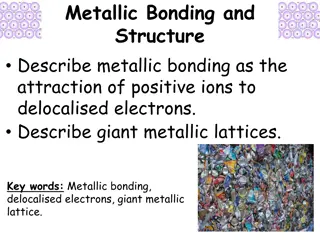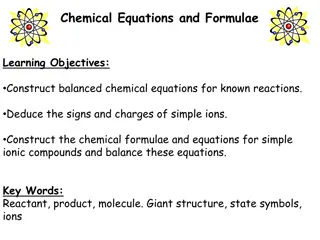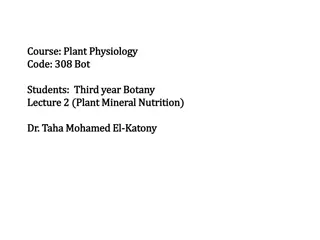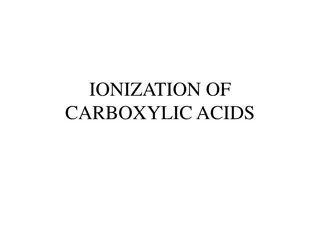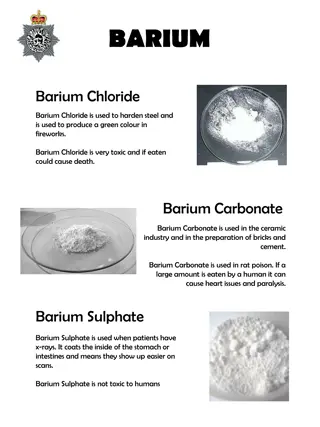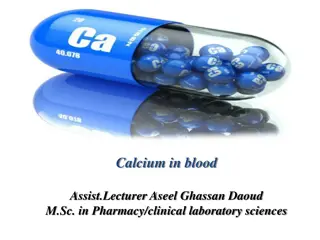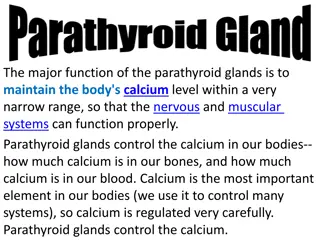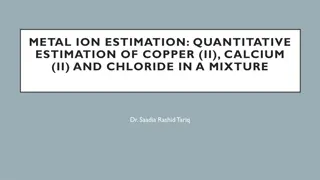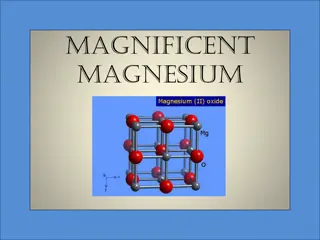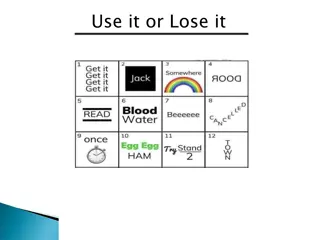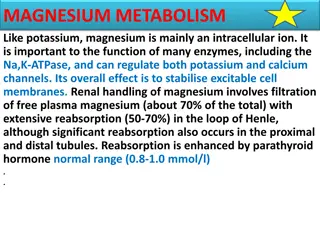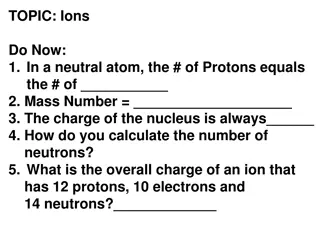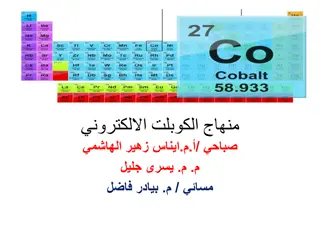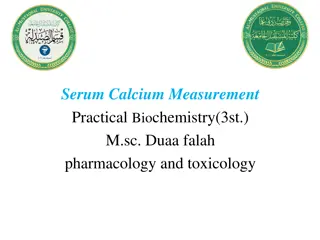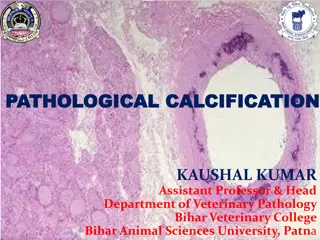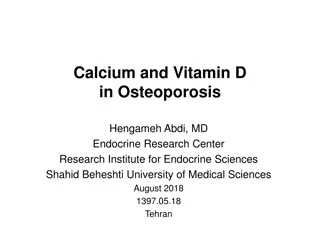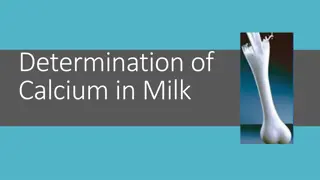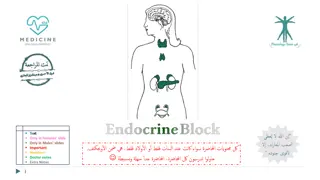Electrolyte and Metabolic Disturbances in the Critically Ill
Dr. Srilekha Ammapalli discusses the cations (sodium, potassium, calcium, magnesium) and anions (chloride, bicarbonate, phosphate, lactate) involved in electrolyte and metabolic disturbances in critically ill patients. The physiology, causes of abnormalities, diagnosis, evaluation, and management of
2 views • 104 slides
Understanding Ionic and Covalent Bonding in Chemistry
Ionic bonding involves the transfer of electrons between a metal and a non-metal to form a giant lattice structure, like in sodium chloride and lithium oxide. Covalent bonding, on the other hand, occurs between non-metals, resulting in giant covalent structures or simple molecules. Examples such as
2 views • 79 slides
Food Grade Magnesium Derivatives Market Size & Share | Growth Outlook 2032
The food grade magnesium derivatives market size was valued at around USD 876.3 Mn in 2022 and is estimated to reach USD 1443.1 Mn by 2031, expanding at a CAGR of 6.5% during the forecast period, 2023 \u2013 2031.
0 views • 5 slides
Magnesium Oxide Market Size, Worth, Overview, Scope & Analysis to 2022-2029
The Magnesium Oxide Market\u00a0research, a thorough examination of the state of the industry, market size, demand trends, development patterns, and projections from 2022 to 2029, was just published by Adroit Market Research.
0 views • 5 slides
Understanding Calcium Metabolism: A Comprehensive Overview
Calcium metabolism plays a critical role in various bodily functions like nerve conduction, coagulation, and bone mineralization. It involves processes such as calcium absorption, distribution, and homeostasis, regulated by hormones like PTH and calcitriol. The balance of calcium in the body is cruc
7 views • 50 slides
Understanding Metallic Bonding and Giant Metallic Lattices
Metallic bonding involves the attraction of positive metal ions to delocalized electrons, forming giant metallic lattices. In this structure, positive metal ions occupy fixed positions while electrons move freely throughout. This bonding is different from covalent bonding as it is delocalized, leadi
1 views • 19 slides
Pharmacology of Drugs Used in Calcium & Vitamin D Disorders
Calcium and vitamin D play crucial roles in regulating bone health and overall calcium balance in the body. Hormones like PTH, vitamin D, and calcitonin are pivotal in maintaining calcium homeostasis. Drugs such as teriparatide, a synthetic form of PTH, are used to treat conditions like osteoporosis
0 views • 9 slides
Understanding Chemical Equations and Formulae
Learn to construct balanced chemical equations for known reactions, deduce signs and charges of simple ions, and create chemical formulae for ionic compounds. Understand the concepts of reactants, products, molecules, giant structures, state symbols, and chemical formulas for various substances. Gai
3 views • 7 slides
Chemistry Concepts: Valence Electrons, Ion Charges, and Ionic Compounds
Explore various key concepts in chemistry such as valence electrons in magnesium, Lewis Dot structure for silicon, charges on ions like strontium, formation of ions to achieve noble-gas electron configuration, elements forming ions with specific charges, and the octet rule. Learn about the character
1 views • 48 slides
Analysis of 1st Group of Cations: Ag+ and Pb2+ Ions
The analysis of cations in the 1st group involving Ag+ and Pb2+ ions is carried out by precipitating insoluble chloride salts in the presence of diluted HCl solution. The solubility products of AgCl, PbCl2, and Hg2Cl2 play a crucial role in the precipitation reactions. Various reagents such as HCl,
0 views • 7 slides
Understanding the Gibbs-Donnan Effect in Biological Systems
The Gibbs-Donnan Effect, named after physicists Gibbs and Donnan, explains the selective permeability of membranes to ions, leading to the establishment of Donnan potential. This phenomenon affects the distribution of ions and proteins across cell membranes, influencing processes like osmosis and io
0 views • 27 slides
Plant Mineral Nutrition: Absorption and Circulation of Ions in Roots
Plant mineral nutrition involves the absorption and translocation of ions across roots. Salts are absorbed passively and actively, with ions moving into the root's apoplasm via free diffusion. The Casparian strip in endodermal cells acts as a barrier, allowing ions to pass only through the protoplas
0 views • 27 slides
Understanding Ionization of Carboxylic Acids
Carboxylic acids, as proton donors, can undergo ionization to form ions in chemical reactions based on the Brønsted-Lowry theory. Ionization involves the complete loss or gain of electrons, leading to the formation of cations (positively charged ions) and anions (negatively charged ions). Through e
0 views • 13 slides
Understanding Complex Ions and Coordinate Bonds in Chemistry
Complex ions in chemistry are formed when transition metals or their ions bond with ligands through coordinate bonds. Ligands utilize their lone pairs of electrons to form dative covalent bonds with transition metals, determining the coordination number of the cation. Complex ions play a crucial rol
1 views • 29 slides
Understanding Valence Electrons and Ionic Charges in Elemental Bonding
Valence electrons play a crucial role in the formation of ions as elements combine. Nonmetals gain electrons to become negatively charged ions, while metals lose electrons to become positively charged ions. This process leads to the creation of electrically attractive elements open for bonding. The
0 views • 17 slides
Understanding Direct Titration in Analyzing Soil Composition
Exploring the concept of direct titration in soil analysis, focusing on its role in determining the concentration of compounds such as calcium and magnesium ions. This method involves the direct reaction between the unknown compound and a known compound, without the need for excess reagents. Learn h
1 views • 34 slides
Chemical Compounds Overview: Barium, Calcium, Sodium, Lithium
Learn about the uses and potential dangers of Barium Chloride, Barium Carbonate, Barium Sulphate, Calcium Chloride, Calcium Carbonate, Calcium Sulphate, Sodium Chloride, Sodium Carbonate, Sodium Sulphate, Lithium Chloride, Lithium Carbonate, and Lithium Sulphate in various industries and application
0 views • 4 slides
Understanding Atoms, Ions, and Isotopes in Chemistry
Atoms are neutral with equal protons and electrons. Ions are charged atoms resulting from gaining or losing electrons, while isotopes are atoms with varying numbers of neutrons. The atomic number always signifies the number of protons in an atom, unaffected by electron or neutron changes. Explore th
2 views • 5 slides
Understanding Calcium Levels in the Body: Importance, Factors, and Testing
Explore the significance of calcium levels in the body, factors influencing them, conditions like hypocalcemia and hypercalcemia, symptoms, why calcium tests are done, and the role of calcium supplements. Learn about the impact on overall health and the importance of maintaining balanced calcium lev
5 views • 17 slides
Understanding Parathyroid Glands and Calcium Regulation
Parathyroid glands play a crucial role in maintaining the body's calcium levels within a narrow range to support the proper functioning of the nervous and muscular systems. Parathyroid hormone (PTH) regulates calcium concentration in the blood, impacting bone health and other physiological functions
4 views • 18 slides
Understanding Acids, Bases, and Neutrals in Natural Sciences Grade 7
Acids, bases, and neutrals are vital substances found in various settings like factories and laboratories. They exhibit distinct properties, with acids feeling rough, being corrosive, and containing hydrogen ions, while bases feel slippery, taste bitter, and contain hydroxide ions. While acids like
0 views • 15 slides
Quantitative Estimation of Metal Ions in a Mixture
Dr. Saadia Rashid Tariq explains the quantitative estimation of copper(II), calcium(II), and chloride in a mixture. The process involves iodometric titration for copper(II), complexometric titration for calcium(II), and gravimetric estimation for chloride. Detailed procedures, reactions, requirement
1 views • 8 slides
The Importance of Magnesium for Good Health
Magnesium is a vital mineral essential for good health, with benefits including muscle and nerve function support, maintaining heart rhythm, and keeping bones strong. It is involved in over 300 bodily reactions and is abundant in the body, primarily in bones. Sources of magnesium include nuts, beans
0 views • 9 slides
Insights on Presolar Silicates and Magnesium Isotopes
Primitive meteorites contain presolar grains with unique isotopic compositions, paving the way for the study of stardust from stars to laboratories. Ion imaging techniques reveal the abundant presence of presolar silicates, showcasing advancements in in situ studies facilitated by cutting-edge techn
0 views • 17 slides
Understanding the Importance of Calcium for Bone Health
Adequate calcium consumption is crucial for maintaining healthy bones, teeth, and overall body function. Failure to achieve peak bone mass in adulthood could lead to conditions like osteoporosis. Calcium-rich foods like dairy products, dark green leafy vegetables, and fortified foods play a vital ro
0 views • 18 slides
Understanding Magnesium Metabolism and Hypomagnesaemia
Magnesium, mainly an intracellular ion, plays a crucial role in enzyme function and cell membrane stability. Its renal handling involves filtration and reabsorption, with hypomagnesaemia often linked to hypocalcaemia. Causes include inadequate intake, excessive losses from GI and urinary sources, an
0 views • 17 slides
Understanding Ions and Their Importance in Your Body
Neutral atoms have the same number of protons and electrons, with the charge of the nucleus always positive. The mass number is the sum of protons and neutrons. The number of neutrons can be calculated by subtracting the atomic number from the mass number. Ions are atoms with a positive or negative
0 views • 15 slides
Importance of Calcium and Phosphorus in Animal Nutrition
Calcium and phosphorus are crucial minerals for animal health, with calcium being the most abundant mineral in the body. They play essential roles in nerve impulse transmission, muscle contraction, and bone structure. Deficiencies in these minerals can lead to conditions like rickets, osteomalacia,
0 views • 11 slides
Techniques for Separating Mixtures: A GCSE Guide
Explore various separating techniques such as chromatography, distillation, filtration, and crystallization for different mixtures in a GCSE science context. Learn how to separate substances like solutes, solvents, liquids with similar boiling points, magnesium, salt, and more. Engage in a challengi
0 views • 5 slides
The Importance of Dairy Products for Your Health
Dairy products are essential for providing nutrients like calcium, vitamin D, and protein. They help in bone and muscle health, blood clotting, and nerve function. If you are lactose intolerant, there are alternative sources to get calcium. Meeting the recommended daily allowance of calcium is cruci
0 views • 11 slides
Understanding Electrolyte Activity Coefficients and Equilibrium Constants
This article delves into the practical aspects of dealing with individual ions in aqueous solutions, particularly focusing on partitioning thermodynamic parameters between ions in salts. It explores the Debye-Hückel theory, which explains the electrostatic interactions between ions in solution and
0 views • 20 slides
Understanding Calcium Influence on Earthworm Behavior in Forest Ecosystems
Earthworm biomass dominance by Lumbricus terrestris in the Siemianice Experimental Forest is linked to their high calcium requirements, as indicated by their calciferous glands producing calcium carbonate to regulate blood pH in the face of high soil CO2 levels. The positive relationship between for
0 views • 8 slides
Detecting Cobalt(II) Ion Reactions in Solutions
This experiment outlines various methods for detecting Cobalt(II) ions (Co2+) in solution using reagents like sodium hydroxide, ammonia, sodium or potassium carbonate, and more. Observations and changes in color are noted throughout the process to identify the presence of the Cobalt ions. The reacti
0 views • 19 slides
Understanding Serum Calcium Measurement in Practical Biochemistry
Calcium is a crucial mineral for various bodily functions like muscle and nerve signaling, heart health, and bone formation. Serum calcium tests help screen for bone diseases and calcium disorders by measuring the amount of calcium in the blood. Two types of tests, total calcium and ionized calcium,
0 views • 12 slides
Understanding Calcium Homeostasis and Its Importance in the Body
Calcium homeostasis plays a crucial role in various physiological functions, including bone integrity, blood clotting, enzymatic regulation, hormonal secretion, neurotransmitter release, nerve excitability, and muscle contraction. Bones act as a major calcium reservoir, with blood containing 50% ion
0 views • 17 slides
Understanding Pathological Calcification in Veterinary Pathology
Pathological calcification is the abnormal deposition of calcium salts in soft tissues, with two forms - dystrophic and metastatic calcification. Dystrophic calcification occurs in dying tissues, while metastatic calcification reflects a derangement in calcium metabolism. Dystrophic calcification ca
0 views • 11 slides
Update on Calcium and Vitamin D Supplementation in Osteoporosis
The study reviews the benefits and risks of calcium and vitamin D supplementation for bone health. It discusses the impact on bone loss, fracture prevention, fall prevention, and cardiovascular risks. Evidence suggests that increasing calcium intake may have limited effects on bone mineral density a
0 views • 30 slides
Importance of Calcium in Milk for Bone Health
Calcium is a crucial mineral essential for maintaining strong bones and teeth, muscle function, and blood circulation. This article discusses the significance of calcium, recommended daily intakes, sources of calcium in milk, and a complexometric titration method for determining calcium levels. Milk
0 views • 10 slides
Preparation of Calcium Peroxide (CaO2) in Inorganic Chemistry Practical II
This practical experiment details the preparation of calcium peroxide, a solid peroxide used in various industries and agriculture. The procedure involves the reaction of calcium salt and sodium peroxide to synthesize calcium peroxide, which has applications in agriculture, aquaculture, ecological r
0 views • 7 slides
Understanding Parathyroid Disorders - Calcium Metabolism and Hormonal Regulation
This presentation covers the functions of calcium, calcium metabolism, bone physiology, and hormonal regulation of calcium metabolism focusing on parathyroid hormone, calcitonin, and Vitamin D. It discusses hypo and hyperparathyroidism in detail, including clinical manifestations and treatment optio
0 views • 15 slides





